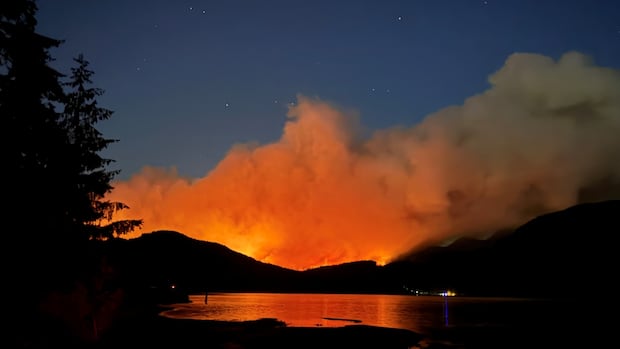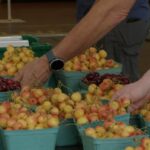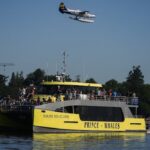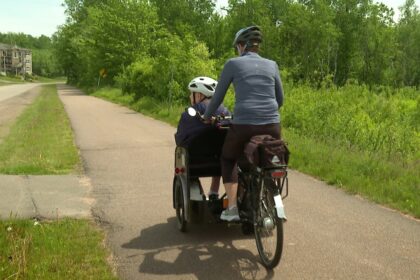British Columbia·Q&AThe Mount Underwood fire, which caused evacuations, power outages, and road closures west of Port Alberni, B.C., is one of the biggest wildfires on Vancouver Island in the past 100 years. But experts say wildfires are becoming more common in the region as climate change brings warmer and drier conditions.With Vancouver Island becoming warmer and drier, wildfires will be more common, forestry prof saysCBC News · Posted: Aug 24, 2025 10:00 AM EDT | Last Updated: 2 hours agoThe Mount Underwood wildfire is seen burning south of Port Alberni, B.C., on Monday, Aug. 11, 2025. The B.C. Wildfire Service declared it as ‘being held’ on Aug. 21. (Evan Hammond/The Canadian Press)The Mount Underwood fire, which grew explosively after it was discovered Aug. 11, is a “harbinger” of what’s ahead for Vancouver Island in the years to come, according to a B.C.-based wildfire expert. The fire, burning near the island city of Port Alberni, B.C., is now classified as “being held” by the B.C. Wildfire Service — meaning it is not expected to grow. While no homes were lost, several communities were without power for almost two weeks after more than 50 power poles burned in remote areas. Lori Daniels, a UBC forestry professor with a focus on wildfires, told CBC that the fire is one of the biggest in about 100 years of record-keeping on Vancouver Island — and that significant wildfires are expected to become more frequent as climate change impacts coastal forests. She spoke to CBC host Gregor Craigie about the history and future of wildfires on Vancouver Island. This interview has been edited for length and clarity.How rare, or not, is a fire of this size on Vancouver Island?What we found is there’s fires at the turn of the last century, in the early 1900s. Many of those were associated with early logging, with cutblocks that were left with large amounts of slash. We used to cherry-pick which species were harvested and then used for lumber products. Many of the trees were cut and left behind, so lots of wood left behind, lots of woody debris. And as we know, the warmest and driest part of the year is the heat of the summer. You can imagine those cutblocks are very exposed. The wood is exposed, it dries out, and it was susceptible to fire.So if we go back to the early 1920s and 30s in British Columbia, in Washington state, down in Oregon as well, there were fires that were fairly large on the west slope of the coastal ranges that had substantive impacts on our society. But most of those again were related to early logging blocks and much of that slash.This is Vancouver IslandWhy wildfire is more common on the island, and what some people are doing about itThe Wesley Ridge and Mount Underwood fires had the province’s attention this summer – an unusual situation for the island. But the people who study fire and climate aren’t surprised, and say it will only become more common. On this week’s episode we hear about the changing history of wildfire on Vancouver Island, and about one of the mitigation projects underway to try and prepare. Hear about how what’s growing in our forests may change, and ways you can help with mitigation. On the west side of Vancouver Island, and in our wet coastal forest, fire was not historically a large portion of how our ecosystems functioned. But if you come to the east side of Vancouver Island, if we look at old maps going back to the 1850s and 60s when the first surveys were done by settlers and by colonial agencies and government agencies, we actually see that the landscape on the east side of Vancouver Island was very different with Garry oak woodlands, with what were called pine plains that had Douglas-firs and grassy understories.And those were sustained by Indigenous cultural fire by the Coast Salish people up and down Vancouver Island. And fire was an important part of those ecosystems, but a very different type of fire than what we’ve observed in the past couple of months.You talked about how human activity, in particular, may have contributed to some of those bigger fires in the past. And how does that, and understanding other causes of past fires, help us in the future, hopefully?So we know that in our coastal region, we don’t have nearly as much lightning, and lightning ignitions in the historical record are much lower than in the Interior. Simply, our weather systems are different. The influence of the ocean giving us a more mesic (moderately moist) environment. Kind of a wetter, cooler environment right next to the ocean really tempers the conditions here. But at the same time, we have seen and we see it in the instrumental record that it’s becoming warmer and drier with longer droughts developing. We’ve seen that in coastal B.C. over the last decade, many years we’ve been in high fire danger, extreme fire danger with prolonged droughts…We’ve seen repeat fires in our coastal forests up the Sunshine Coast, over in Zeballos on the west side of Vancouver Island, some of our wettest ecosystems. And then of course, the fires in 2023 and 2025 on Cameron Lake and then of course, the fires out of Port Alberni this summer. We’re going to have to think carefully about how we are managing our forests, how we are managing logging residues. We have to think carefully about the forests surrounding our neighbourhoods and communities. Second-growth forests are more susceptible to fire than the old-growth forests here in our coastal conditions, but most of our communities are surrounded by second-growth forests.That’s going to require proactive management to think about how to make those forests resilient again. And it will mean in those forests around communities … thinking about thinning and thinking about managing the fuels on the ground that are contributing to the smouldering combustion that creates all of that smoke that we’ve all been impacted by.And you mentioned the Underwood fire is a harbinger of things to come. Does the extent to which it becomes the norm in the future, can that be significantly altered by forest management practices, in your view?Fire, and fire behaviour, is a mixture of weather and climate, the topography and the fuels, and the fuels are the condition of the forest. And so that’s the component that we can alter and change and that we can manage for. We know that warmer, drier conditions are coming. We know that the droughts are more severe and longer, and we can’t change our mountainous topography. On the one hand, it’s beautiful, and it gives us amazing environments to live in, but it also makes it very tricky and very challenging to put out those fires. So that leaves us the fuels to manage for and to think about ways that we can make those ecosystems more resilient.The Mount Underwood wildfire near the China Creek Campground and Marina on Vancouver Island is seen on Aug. 11, 2025. It is one of the biggest fires to burn on the Island in the past century. (B.C. Wildfire Service)It’s also important for us to remember that most of the ecosystems around us have been highly altered in the last century.And many of our changes, whether they’re industrial forest management or our attempts to control all fires or our removal of Indigenous fire stewardship, has, in combination, meant that our landscapes have changed and largely become more loaded with trees and fuels that are very flammable.And so that challenges us to think creatively, to deeply understand how our ecosystems function, and to come up with ways that the forest can be managed differently than we have been for many decades, to think about resilience, to maintain biodiversity and create resilience for our communities as well.What about replanting? Should the same species be planted in Vancouver Island forests, or would you have different recommendations?I think we’ve done an excellent job in British Columbia to make sure that we focus on our native tree species and continue to grow back our native tree species. We plant the Douglas-firs, cedars and other species that we consider high priority.We are paying attention to seed sources that might be more resilient to climate change and the warmer, drier climate. So there are some really good experiments and trials underway to look at seed sources from further south, where they’ll be better adapted to the climate coming towards us, but still our same native species. And thinking about how to be resilient to climate, to the insects, the pathogens and fire that come with climate change and interact with that changing climate. So diversifying our forests, the tree species within every patch of forest, diversifying our landscapes and managing to make sure that we’re reducing the amount of fuel load left behind through our industrial forest management is going to be critical in all parts of the province moving forward.With files from On The Island
Mount Underwood fire a ‘harbinger’ of future Island fires, says wildfire specialist










